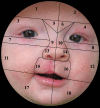Parents of Children with Cleft Lip Exhibit Heightened Visual Attention to the Perioral Area
- PMID: 36798720
- PMCID: PMC9925101
- DOI: 10.1097/GOX.0000000000004790
Parents of Children with Cleft Lip Exhibit Heightened Visual Attention to the Perioral Area
Abstract
Following high-quality surgical repair, children born with a cleft lip anomaly may still display lasting visual differences. We exposed control adults and parents of affected children to images of children with cleft deformity and compared their visual tracking patterns. The protocol investigated whether parental exposure to secondary cleft deformity heightens or diminishes visual attraction to this type of structural facial variation.
Method: Twenty participants (10 control adults, 10 parents of affected children) assessed 40 colored images of children's faces while their eye movements were tracked. Twenty-four control images and 16 repaired cleft lip images were displayed to observers. Nine bilateral facial aesthetic zones were considered as regions of interest. Percentage of time visually fixating within each region, and statistical differences in fixation duration percentage between the two participant groups and across the bilateral regions of interest were analyzed.
Results: While both groups of observers directed more visual attention to the nasal and oral regions of the cleft images than control images, parents of children with cleft lip spent significantly more time fixating on these areas (25% and 24% of the time, respectively) than did unaffected adults (14.6% and 19.3%; P < 0.001).
Conclusions: These results demonstrate that parents of cleft lip children exhibit heightened attention to this type of facial difference relative to the naive observer. These findings highlight that observer profile can meaningfully influence the perception of a facial deformity. Awareness of this information may enhance communication between surgeon and parents of an affected child by providing added insight into parental perspective.
Copyright © 2023 The Authors. Published by Wolters Kluwer Health, Inc. on behalf of The American Society of Plastic Surgeons.
Conflict of interest statement
Disclosure: The authors have no financial interest to declare in relation to the content of this article.
Figures




Similar articles
-
Measuring visual attention to faces with cleft deformity.J Plast Reconstr Aesthet Surg. 2019 Jun;72(6):982-989. doi: 10.1016/j.bjps.2018.12.024. Epub 2018 Dec 14. J Plast Reconstr Aesthet Surg. 2019. PMID: 30598394
-
Developing an Eye-Tracking Protocol to Determine Children's Visual Perception of Secondary Cleft Lip Deformity.Cleft Palate Craniofac J. 2020 Mar;57(3):321-326. doi: 10.1177/1055665619868332. Epub 2019 Aug 12. Cleft Palate Craniofac J. 2020. PMID: 31405288
-
Children's Visual Perception of Facial Scarring and Cleft Lip Deformity Using Eye Tracking Data.Laryngoscope. 2024 Jun;134(6):2726-2733. doi: 10.1002/lary.31267. Epub 2024 Jan 12. Laryngoscope. 2024. PMID: 38214383
-
Visual facial perception of postsurgical cleft lip scarring assessed by laypeople via eye-tracking.J Orthod Sci. 2021 Oct 15;10:20. doi: 10.4103/jos.JOS_76_20. eCollection 2021. J Orthod Sci. 2021. PMID: 34760813 Free PMC article.
-
Scandcleft randomised trials of primary surgery for unilateral cleft lip and palate: 10. Parental perceptions of appearance and treatment outcomes in their 5-year-old child.J Plast Surg Hand Surg. 2017 Feb;51(1):81-87. doi: 10.1080/2000656X.2016.1254642. J Plast Surg Hand Surg. 2017. PMID: 28218558 Review.
References
-
- Walker-Smith GJ, Gale AG, Findlay JM. Eye movement strategies involved in face perception. Perception. 1977;6:313–326. - PubMed
-
- Gillham J, Anand S, Bullen P. Antenatal detection of cleft lip with or without cleft palate: incidence of associated chromosomal and structural anomalies. Ultrasound Obstet Gynecol. 2009;34:410–415. - PubMed
-
- Mossey PA, Little J, Munger RG, et al. . Cleft lip and palate. Lancet Glob Health. 2009;374:1773–1785. - PubMed
-
- van Schijndel O, Litschel R, Maal TJ, et al. . Eye tracker based study: perception of faces with a cleft lip and nose deformity. J Craniomaxillofac Surg. 2015;43:1620–1625. - PubMed
LinkOut - more resources
Full Text Sources
